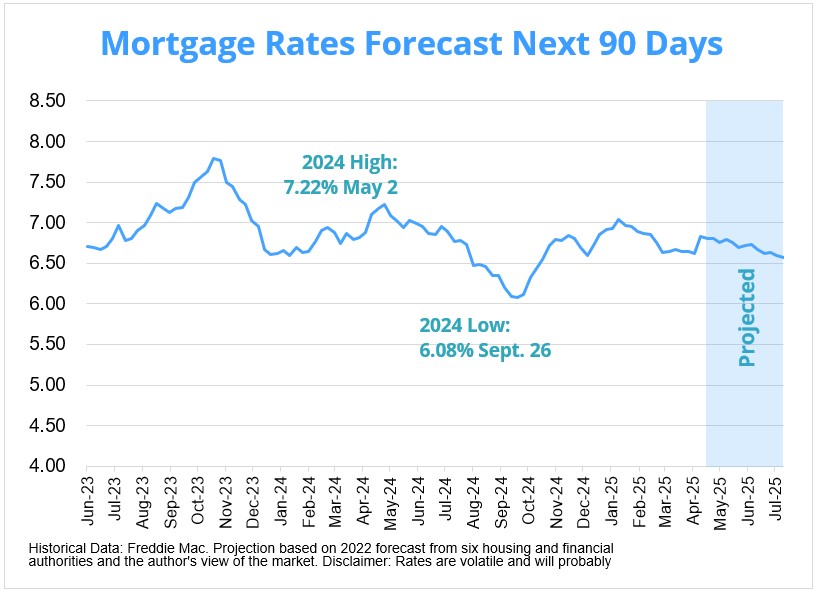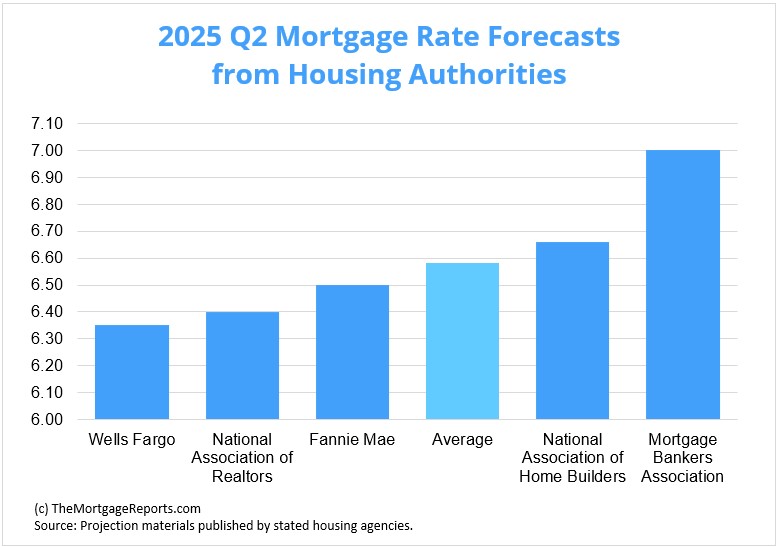Mortgage rate forecast for next week (June 9-13)
After three straight weeks of growth, mortgage rates came back down.
The average 30-year fixed rate mortgage (FRM) declined to 6.85% on June 5 from 6.89% on May 29, according to Freddie Mac. It marks 20 straight weeks below 7% for the average 30-year FRM.
“Mortgage rates near 7 percent are keeping mortgage activity in a holding pattern,” said Bob Broeksmit, CEO of the Mortgage Bankers Association. “Although refinance and home purchase applications are consistently higher than last year’s pace, we expect activity to remain within the same narrow range until mortgage rates move lower. MBA expects mortgage rates to decline to 6.6 percent by the end of 2025, which should increase demand.”
Find your lowest mortgage rate. Start hereIn this article (Skip to...)
- Will rates go down in June?
- 90-day forecast
- Expert rate predictions
- Mortgage rate trends
- Rates by loan type
- Mortgage strategies for June
- Mortgage rates FAQ
Will mortgage rates go down in June?
“Home shoppers in June would be wise to anticipate some volatility and be prepared to respond nimbly.”
-Danielle Hale, chief economist at Realtor.com
Mortgage rates fluctuated significantly in 2023, with the average 30-year fixed rate going as low as 6.09% and as high as 7.79%, according to Freddie Mac. That range narrowed in 2024, with a spread of 6.08% to 7.22%.
Find your lowest mortgage rate. Start hereWith the economy probably heading into a recession, we may have already seen the peak of this rate cycle. But if inflation rises, mortgage rates could uptrend. Of course, interest rates are driven by many factors and notoriously volatile, so they could change direction any given week.
Experts from Realtor.com, First American, and others weigh in on whether 30-year mortgage rates will climb, fall, or level off in June.
Expert mortgage rate predictions for June

Molly Boesel, principal economist at Cotality
Prediction: Rates will moderate
“The fate of the 30-year mortgage rate in the near-term rests with the bond market and that market’s reactions to long-run U.S. debt and deficit. Once there is clarity around the U.S. budget, long-term rates should settle down, which could lead to some slightly lower mortgage rates. For now, look for the 30-year mortgage rate to hover in the 6.8% to 6.9% range in June 2025.”

Ralph DiBugnara, founder at Home Qualified
Prediction: Rates will moderate
“June has yet to give us any indication that we will see a significant reduction on rates. We are currently back in one of the highest average mortgage rates markets that we’ve experienced since the beginning of the year. Inflation is showing signs of slowly coming down, which is great news for mortgage rates. But without some sort of significant occurrence, that reduction is going to take some time. Tariff talks have further complicated the matter of prices coming down, which is keeping the 10-year Treasury yield and mortgage rates higher.
“For June, we should see a 30-year fixed mortgage rate average 6.875% and the 15-year fixed mortgage rate average 6.375%.”

Jon Dovidio, chief strategy officer at Equity Protect
Prediction: Rates will decrease
“I expect mortgage rates in the U.S. to gradually decrease over the summer of 2025. This decline will likely be driven by easing inflation and the potential for the Federal Reserve to begin cutting interest rates. Even a modest drop could provide some relief for future home buyers and for those looking to refinance after purchasing in recent years at higher rates.”

Danielle Hale, chief economist at Realtor.com
Prediction: Rates will increase
“Mortgage rates have been relatively steady since mid-April, but, more recently, 10-year Treasury yields have climbed as a downgrade of the U.S. credit rating by Moody’s sharpened the focus on concerns about the U.S. fiscal situation. U.S. mortgage rates are likely to follow suit and edge higher in the near term. At the same time, policy changes stemming from trade deals and the tax bill currently working its way through Congress raise the odds of an unanticipated pivot, so home shoppers in June would be wise to anticipate some volatility and be prepared to respond nimbly.”

Sam Williamson, senior economist at First American
Prediction: Rates will moderate
“Mortgage rates are expected to remain in the mid-to-upper 6% range in June. Although rates have dropped slightly from their peak of 7% in January, the decline has been sluggish and uneven amid a fog of uncertainty—spanning economic conditions, fiscal policy, and monetary policy— that continues to cloud the outlook of the U.S. economy and keep borrowing costs elevated.
“The ongoing volatility in markets is due to several factors. Investors remain concerned about inflationary pressures from tariffs on imported goods, with major retailers like Walmart starting to announce plans to raise prices on certain items. This uncertainty on inflation has also slowed the Fed’s expected path for interest rate cuts. The central bank left its benchmark rate unchanged in May for the third consecutive meeting, noting that the risks of both higher inflation and rising unemployment have increased, in part due to trade policy. At the same time, proposed tax cuts and the recent downgrade of U.S. debt have amplified concerns about rising government debt and deficits among bond investors. Collectively, these factors have pushed up the 10-year Treasury rate, which mortgage rates tend to follow. Provided that fiscal and trade uncertainties diminish, a gradual decline in mortgage rates may take shape in the second half of the year.”
Mortgage interest rates forecast next 90 days
As inflation ran rampant in 2022, the Federal Reserve took action to bring it down and that led to the average 30-year fixed-rate mortgage spiking in 2023.
With inflation gradually cooling, the Fed made three rate cuts in 2024 (September, November, and December). Heading into 2025, many experts believed mortgage interest rates would gradually descend.
Find your lowest mortgage rate. Start hereOf course, rates could rise on any given week or if another global event causes widespread uncertainty in the economy.

Mortgage rate predictions for 2025
The 30-year fixed-rate mortgage averaged 6.89% as of May 29, according to Freddie Mac. Four of the five major housing authorities we looked at predict 2025’s second quarter average to below that.
Wells Fargo sits at the low end of the group, projecting the average 30-year fixed interest rate to settle at 6.35% for Q2. Meanwhile, the Mortgage Bankers Association had the highest forecast of 7%.
| Housing Authority | 30-Year Mortgage Rate Forecast (Q2 2025) |
| Wells Fargo | 6.35% |
| National Association of Realtors | 6.40% |
| Fannie Mae | 6.50% |
| National Association of Home Builders | 6.66% |
| Mortgage Bankers Association | 7.00% |
| Average Prediction | 6.58% |

Current mortgage interest rate trends
Mortgage rates decreased following three weeks of growth.
The average 30-year fixed rate ticked down to 6.85% on June 5 from 6.89% on May 29. The average 15-year fixed mortgage rate similarly dipped to 5.99% from 6.03%.
| Month | Average 30-Year Fixed Rate |
| May 2024 | 7.06% |
| June 2024 | 6.92% |
| July 2024 | 6.85% |
| August 2024 | 6.50% |
| September 2024 | 6.18% |
| October 2024 | 6.43% |
| November 2024 | 6.81% |
| December 2024 | 6.72% |
| January 2025 | 6.96% |
| February 2025 | 6.84% |
| March 2025 | 6.65% |
| April 2025 | 6.73% |
| May 2025 | 6.82% |
Source: Freddie Mac
After hitting record-low territory in 2020 and 2021, mortgage rates climbed to a 23-year high in 2023 before descending somewhat in 2024. Many experts and industry authorities believe they will follow a downward trajectory into 2025. Whatever happens, interest rates are still below historical averages.
Dating back to April 1971, the fixed 30-year interest rate averaged around 7.8%, according to Freddie Mac. So if you haven’t locked a rate yet, don’t lose too much sleep over it. You can still get a good deal, historically speaking — especially if you’re a borrower with strong credit.
Just make sure you shop around to find the best lender and lowest rate for your unique situation.
Mortgage rate trends by loan type
Many mortgage shoppers don’t realize there are different types of rates in today’s mortgage market. But this knowledge can help home buyers and refinancing households find the best value for their situation.
Find your lowest mortgage rate. Start hereWhich mortgage loan is best?
The best mortgage for you depends on your financial situation and your goals.
For instance, if you want to buy a high-priced home and you have great credit, a jumbo loan is your best bet. Jumbo mortgages allow loan amounts above conforming loan limits, which max out at $ in most parts of the U.S.
On the other hand, if you’re a veteran or service member, a VA loan is almost always the right choice. VA loans are backed by the U.S. Department of Veterans Affairs. They provide ultra-low rates and never charge private mortgage insurance (PMI). But you need an eligible service history to qualify.
Conforming loans and FHA loans (those backed by the Federal Housing Administration) are great low-down-payment options.
Conforming loans allow as little as 3% down with FICO scores starting at 620. FHA loans are even more lenient about credit; home buyers can often qualify with a score of 580 or higher, and a less-than-perfect credit history might not disqualify you.
Finally, consider a USDA loan if you want to buy or refinance real estate in a rural area. USDA loans have below-market rates — similar to VA — and reduced mortgage insurance costs. The catch? You need to live in a ‘rural’ area and have moderate or low income to be USDA-eligible.
Mortgage rate strategies for June 2025
Mortgage rates displayed their famous volatility throughout 2024. Fed cuts in September, November, and December, with the potential for more in 2025 provide optimism for descending rates.
Previously, the central bank held off on a rate hike at eight consecutive meetings, preferring to see if the economy would keep cooling organically. They finally deemed inflation’s downtrend as organic and made its first cuts since 2020.
Find your lowest mortgage rate. Start hereHowever, the Trump Administration’s upward wealth consolidation and ongoing inflation battles forced the Fed to hold in January, March and May. As always, the committee said it would adjust its policies as necessary — which could mean additional cuts or possibly none at all.
Here are just a few strategies to keep in mind if you’re mortgage shopping in the coming months.
Be ready to move quickly
Indecision can lead to failure or missed opportunities. That holds true in home buying as well.
Although the housing market is becoming more balanced than the recent past, it still favors sellers. Prospective borrowers should take the lessons learned from the last few years and apply them now even though conditions are less extreme.
“Taking too long to decide to make an offer can lead to paying more for the home at best and at worst to losing out on it entirely. Buyers should get pre-approved (not pre-qualified) for their mortgage, so that the seller has some certainty about the deal closing. And be ready to close quickly — a long escrow period will put you at a disadvantage.
And it’s definitely not a bad idea to work with a real estate agent who has access to “coming soon” properties, which can give a buyer a little bit of a head start competing for the limited number of homes available,” said Rick Sharga.
If mortgage rates continue on a downward trajectory, more and more buyers will likely enter the market after being priced out on the sidelines. Being decisive (and prepared) should only play to your advantage.
Shopping around isn’t only for the holidays
Since interest rates can vary drastically from day to day and from lender to lender, failing to shop around likely leads to money lost.
Lenders charge different rates for different levels of credit scores. And while there are ways to negotiate a lower mortgage rate, the easiest is to get multiple quotes from multiple lenders and leverage them against each other.
“For potential home buyers, it’s important to get quotes from multiple lenders for a mortgage, as rates can vary dramatically, especially during such a volatile period,” said Odeta Kushi.
As the mortgage market slows due to lessened demand, lenders will be more eager for business. While missing out on the rock-bottom rates of 2020 and 2021 may sting, there’s always a way to use the market to your advantage.
How to shop for interest rates
Rate shopping doesn’t just mean looking at the lowest rates advertised online because those aren’t available to everyone. Typically, those are offered to borrowers with great credit who can put a down payment of 20% or more.
The rate lenders actually offer depends on:
- Your credit score and credit history
- Your personal finances
- Your down payment (if buying a home)
- Your home equity (if refinancing)
- Your loan-to-value ratio (LTV)
- Your debt-to-income ratio (DTI)
To figure out what rate a lender can offer you based on those factors, you have to fill out a loan application. Lenders will check your credit and verify your income and debts, then give you a ‘real’ rate quote based on your financial situation.
You should get three to five of these quotes at a minimum, then compare them to find the best offer. Look for the lowest rate, but also pay attention to your annual percentage rate (APR), estimated closing costs, and ‘discount points’ — extra fees charged upfront to lower your rate.
This might sound like a lot of work. But you can shop for mortgage rates in under a day if you put your mind to it. And shaving just a few basis points off your rate can save you thousands.
Compare mortgage and refinance rates. Start here
Mortgage interest rate FAQ
Current mortgage rates are averaging 6.85% for a 30-year fixed-rate loan and 5.99% for a 15-year fixed-rate loan, according to Freddie Mac’s latest weekly rate survey. Your individual rate could be higher or lower than the average depending on your credit score, down payment, and the lender you choose to work with, among other factors.
Mortgage rates could decrease next week (June 9-13, 2025) if the mortgage market takes a cautious approach to a possible recession. However, rates could rise if lenders account for the Federal Reserve taking measures to counteract inflation or if a global event brings economic uncertainty.
If inflation continues to dissipate and the economy cools or goes into a recession, it’s likely mortgage rates will decrease in 2025. Although, it’s important to remember that interest rates are notoriously volatile and are driven by many factors, so they can rise during any given week.
Mortgage rates may rise in 2025. High inflation, strong demand in the housing market, and policy changes by the Federal Reserve in 2022 and 2023 all pushed rates higher. However, if the U.S. does indeed enter a recession, mortgage rates could come down.
Freddie Mac is now citing average 30-year rates in the 7% range. If you can find a rate in the 5s or 6s, you’re in a very good position. Remember that rates vary a lot by borrower. Those with perfect credit and large down payments may get below-average interest rates, while poor-credit borrowers and those with non-QM loans could see much higher rates. You’ll need to get pre-approved for a mortgage to know your exact rate.
For the most part, industry experts do not expect the housing market to crash in 2025. Yes, home prices are over-inflated. But many of the risk factors that led to the 2008 crash are not present in today’s market. Low inventory and massive buyer demand should keep the market propped up. Plus, mortgage lending practices are much safer than they used to be. That means there’s not a subprime mortgage crisis waiting in the wings.
At the time of this writing, the lowest 30-year mortgage rate ever was 2.65%. That’s according to Freddie Mac’s Primary Mortgage Market Survey, the most widely used benchmark for current mortgage interest rates.
Locking your rate is a personal decision. You should do what’s right for your situation rather than trying to time the market. If you’re buying a home, the right time to lock a rate is after you’ve secured a purchase agreement and shopped for your best mortgage deal. If you’re refinancing, you should make sure you compare offers from at least three to five lenders before locking a rate. That said, rates are rising. So the sooner you can lock in today’s market, the better.
That depends on your situation. It’s a good time to refinance if your current mortgage rate is above market rates and you could lower your monthly mortgage payment. It might also be good to refinance if you can switch from an adjustable-rate mortgage to a low fixed-rate mortgage; refinance to get rid of FHA mortgage insurance; or switch to a short-term 10- or 15-year mortgage to pay off your loan early.
It’s often worth refinancing for 1 percentage point, as this can yield significant savings on your mortgage payments and total interest payments. Just make sure your refinance savings justify your closing costs. You can use a mortgage calculator or speak with a loan officer to crunch the numbers.
Start by choosing a list of three to five mortgage lenders that you’re interested in. Look for lenders with low advertised rates, great customer service scores, and recommendations from friends, family, or a real estate agent. Then get pre-approved by those lenders to see what rates and fees they can offer you. Compare your offers (Loan Estimates) to find the best overall deal for the loan type you want.
What are today’s mortgage rates?
Mortgage rates are rising, but borrowers can almost always find a better deal by shopping around. Connect with a mortgage lender to find out exactly what rate you qualify for.
Time to make a move? Let us find the right mortgage for you1Today's mortgage rates are based on a daily survey of select lending partners of The Mortgage Reports. Interest rates shown here assume a credit score of 740. See our full loan assumptions here.
Selected sources:
- https://www.federalreserve.gov/monetarypolicy/fomccalendars.htm
- http://www.freddiemac.com/research/datasets/refinance-stats/index.page
